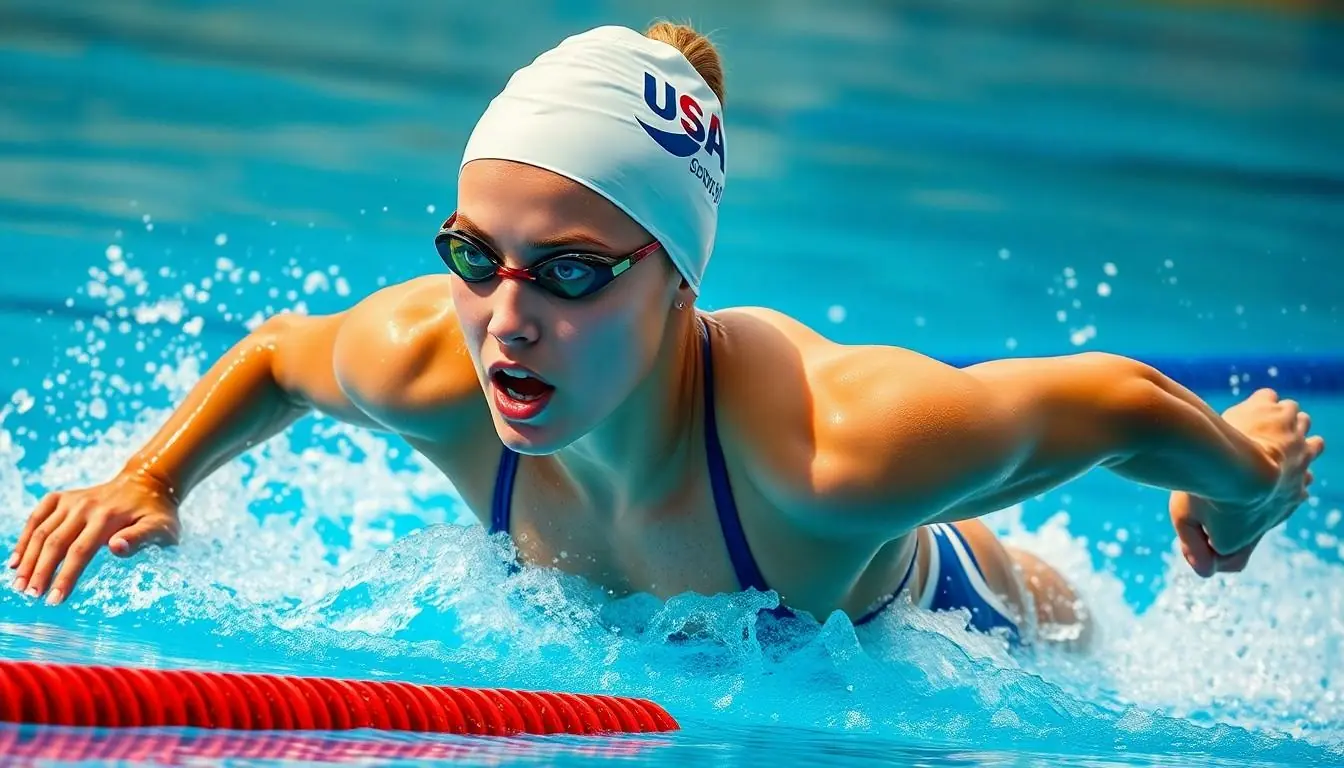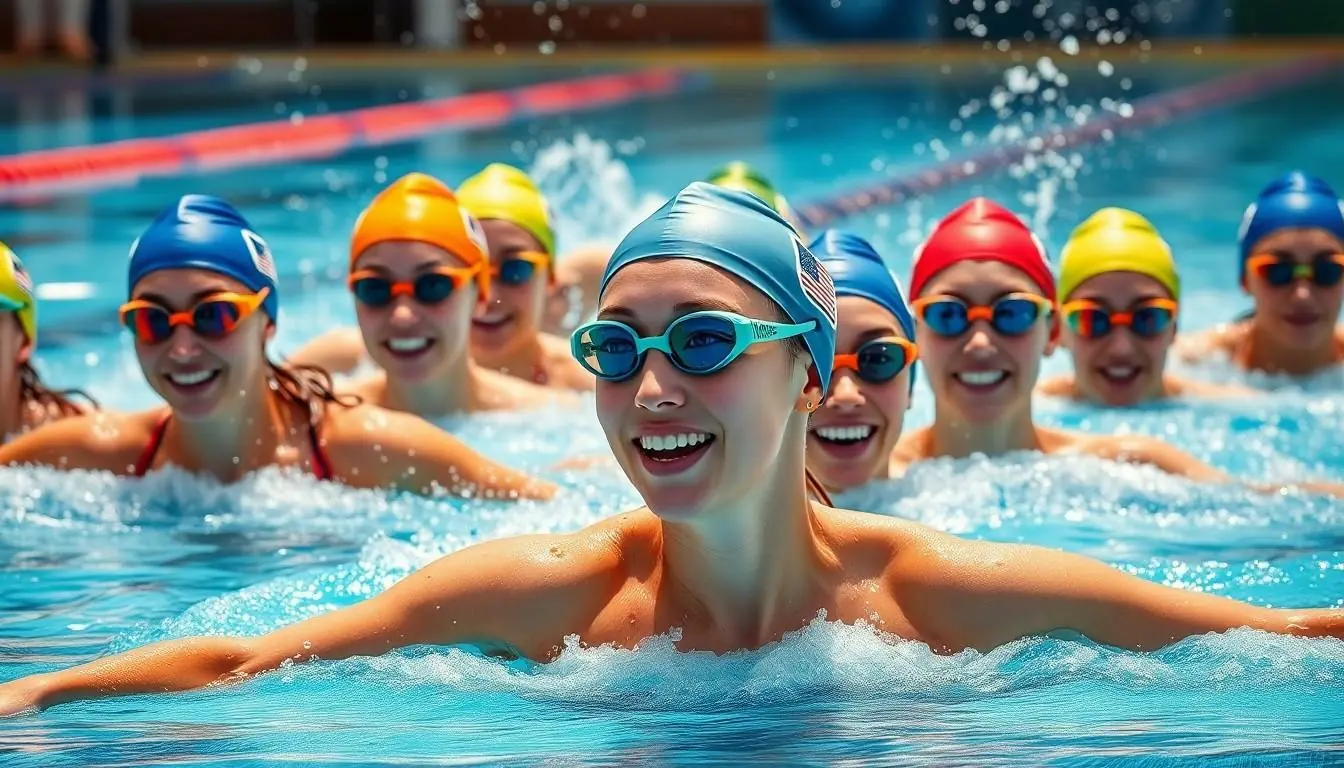Table of Contents
ToggleWomen swimming isn’t just a sport; it’s a splash-tastic celebration of strength, grace, and a whole lot of fun. From synchronized routines that make dolphins jealous to competitive races that could make a cheetah reconsider its speed, women have been making waves in the water for decades. Whether they’re gliding through the pool or conquering open waters, female swimmers are redefining what it means to dive in headfirst.
Overview of Women Swimming
Women swimming encompasses a diverse array of activities, showcasing talent across various disciplines. Competitive swimming features numerous events, including freestyle, breaststroke, butterfly, and individual medley, allowing female athletes to excel in their chosen specialties. Synchronized swimming demands high levels of artistry and teamwork, emphasizing creativity alongside athleticism.
Participation in open water swimming has gained traction among women, highlighting endurance and mental strength. Events such as marathon swimming require excellent navigation skills and adaptability to changing environments, further showcasing women’s versatility. Swim meets attract large audiences, celebrating female athletes’ achievements and inspiring future generations.
Training regimens for women swimmers focus on developing strength, technique, and cardiovascular endurance. Many elite athletes dedicate hours to practice, with schedules that often include dryland workouts, strength training, and recovery sessions. Balancing these commitments with personal lives illustrates the dedication prevalent among female swimmers.
Women swimming fosters camaraderie and support within the community. Many swimmers form bonds that extend beyond competition, creating lasting friendships and networks. These relationships contribute positively to the growth of women’s sports, encouraging greater participation and visibility.
Organizations such as FINA and USA Swimming actively promote women’s participation, providing resources and opportunities for development. Investing in women’s sports not only elevates the athletes but also inspires young girls to pursue swimming, transforming perceptions around women in athletics. These collective efforts enhance the already significant impact women have on the sport, ensuring a bright future ahead.
Historical Context

Women swimming has evolved significantly over time, marked by major milestones and influential figures who shaped the sport.
Milestones in Women Swimming
The inclusion of women’s swimming in the Olympics began in 1912, marking a significant advancement. Events like the 100-meter freestyle and 4×100-meter relay showcased female talent on an international stage. By 1984, synchronized swimming debuted at the Olympics, highlighting creativity alongside athleticism. The introduction of equal prize money in major competitions in the 21st century spurred advancements in professional opportunities. Advances in training techniques and technology subsequently allowed women to break records consistently, further cementing their place in swimming history.
Influential Figures in Women Swimming
Dawn Fraser remains a pivotal figure, known for her groundbreaking successes in the 1960s. Katie Ledecky had shattered numerous world records by 2021, showcasing unparalleled endurance and skill. Similarly, Janet Evans revolutionized middle-distance swimming in the late 1980s with her unique technique. Annette Kellerman, an early advocate for women’s participation in swimming, promoted the sport in the 1900s, challenging societal norms. Each of these women contributed to increased visibility and opened doors for future generations, underscoring the impact of women in swimming.
Benefits of Women Swimming
Women swimming offers numerous advantages that contribute to overall well-being. Engaging in swimming enhances both physical and mental health, providing a comprehensive approach to fitness.
Physical Health Benefits
Swimming serves as a low-impact exercise, reducing strain on joints while effectively building muscle strength. Combating cardiovascular issues, it boosts heart health and improves circulation. Enhanced flexibility results from diverse swimming strokes, promoting a broader range of motion. Regular swimming sessions bolster endurance, allowing participants to perform daily activities more efficiently. Many women experience weight management benefits from consistent swimming, contributing to overall fitness goals. Moreover, swimming can improve lung capacity, fostering better respiratory health and improving oxygen delivery throughout the body.
Mental Health Benefits
Swimming positively impacts mental well-being, offering a meditative experience for many women. Stress reduction occurs through rhythmic movements and the calming effect of water. Regular participation in swimming fosters increased self-esteem and confidence, stemming from skill development and personal achievements. Women often find social connections within the swimming community, creating supportive networks that enhance emotional health. Engaging in this activity can alleviate symptoms of anxiety and depression, promoting overall mood improvement. Women swimming also encourages a sense of accomplishment, as setting and achieving personal goals leads to greater satisfaction and fulfillment.
Current Trends in Women Swimming
Women swimming features significant growth and evolution within competitive and recreational domains. Modern practices reflect a shift in attitudes towards female athletes, celebrating their contributions and achievements.
Competitive Swimming
Competitive swimming showcases women breaking records and redefining the sport. Athletes like Katie Ledecky and Simone Manuel have emerged as icons, pushing boundaries in races such as freestyle and butterfly. Notably, events at major competitions now emphasize equal prize money, encouraging more female participation. Training regimens focus on strength, technique, and endurance, crucial for competing at high levels. Moreover, the increasing visibility of women’s swimming inspires younger generations, leading to a rise in enrollment in swim programs across various age groups.
Recreational Swimming
Recreational swimming offers women an avenue for fitness and social connection. Activities range from lap swimming to aqua aerobics, appealing to various skill levels. Women often report enhanced mental well-being through consistent swimming, citing stress relief and improved self-esteem. Community swim groups foster friendships and support, empowering participants to engage regularly. Accessibility improvements in local pools and public facilities contribute to the popularity of swimming among women, promoting a healthier lifestyle. With endless opportunities, recreational swimming remains a vital part of women’s wellness.
Challenges Faced by Women in Swimming
Women in swimming encounter various challenges that can hinder their participation and success. Addressing these challenges is essential for fostering a more inclusive environment.
Gender Disparities
Gender disparities remain a significant issue in the swimming community. Female athletes often receive less media coverage compared to their male counterparts, resulting in lower visibility. According to a 2020 study, women athletes comprise only 4% of media coverage in sports. Prize money discrepancies also persist, with certain events offering reduced financial rewards for female swimmers. These inequalities contribute to a lack of sponsorship opportunities, making it difficult for women to gain the same recognition and support as men.
Access and Participation Barriers
Access and participation barriers hinder women’s swimming involvement at various levels. Limited access to quality facilities can restrict training opportunities in some regions. Social stigmas surrounding women engaging in sports, particularly in conservative cultures, can also deter participation. Furthermore, inadequate funding for women’s swimming programs leads to fewer resources for training and competition. Addressing these barriers is crucial for empowering women and encouraging greater participation in the sport.
Women swimming is more than just a sport; it’s a powerful movement that showcases determination and resilience. As female athletes continue to break barriers and achieve remarkable feats, they inspire future generations to dive into the water and pursue their passions. The camaraderie within the swimming community fosters an environment where women can thrive both competitively and recreationally.
While challenges remain, the ongoing efforts to promote equality and visibility are paving the way for a more inclusive future. With increasing participation and support from organizations, women swimming is poised to continue its evolution, creating lasting impacts on health, well-being, and empowerment. The journey of women in swimming is just beginning, and the waves they create will resonate for years to come.




